In 1615, a fleet of 80 Zaporozhian Cossack boats, called chaiky, slipped into the harbor of Constantinople and razed the entire area around the harbor to the ground. This was the culmination of a hundred years of naval raids that the Cossacks were conducting against various ports of the Ottoman Empire.
At that time, the Ottoman Empire was the most powerful state in Europe and was on the offensive on all fronts. That did not deter the Cossacks. They were fearless and in subsequent years conducted a few more raids on Ottoman ports. The bigger the challenge, the more likely they were to attempt it. The Zaporozhians were not afraid to take risks, even doing things that seemed impossible.
The year following that raid on Constantinople, they raided the port of Trebizond. The Ottoman Sultan sent a fleet to the mouth of the Dnieper River in order to try to destroy their fleet. However in a show of the ultimate “f*%k you,” the Cossacks who were returning from their successful raid decided to turn around and once again attacked Constantinople. They caused a lot of havoc, even rampaging through the official palace of the Sultan himself.
Brave warriors who cherished their freedom
The Cossacks were brave warriors who cherished their freedom. They had a strict code of honor and valued courage above all else. A Venetian envoy once compared them to the Spartans, only more drunk: “This republic (the Zaporozhian Sich) could be compared to the Spartan, if the Cossacks respected sobriety as highly as did the Spartans.”
The Cossacks learned how to endure many hardships from early on. Their code of honor preached that they always needed to help a friend in trouble. They would often sacrifice themselves in order to save others. Their skills and abilities in horsemanship and with different arms (swords, guns) were legendary.
They could crawl up on an enemy undetected, as well as charge on horseback gun in hand, being able to hit a far-away target with exact precision. They could ride a horse, go on long marches, but also take an oar in hands and battle on the sea. The Cossacks were masters of multiple ways of warfare.
History of the Zaporozhian Cossacks
There were various types of Cossacks. This essay will focus on the Ukrainian Cossacks, particularly the Cossacks of the Zaporozhian Sich. These were probably the most freedom loving and the fiercest of all the Cossack groups.
The first Cossack communities began forming on the wild Ukrainian steppes around the Dnieper River. Many Ukrainian peasants, outlaws, clergy, even nobles began trying to escape from the harsh rule of the Polish-Lithuanian Commonwealth and joined people already inhabiting the area called the Wild Fields. This was a virtual no-man’s land stuck between the lands controlled by the Poles, Russians and the Crimean Tatars.
There they could live free. In order to protect themselves, they began to form fortified camps, one of which was founded on the island of Khortytsia in an area called “beyond the rapids,” Zaporozhie. This was the start of the Zaporozhian Cossacks.
The Zaporozhian society was one based on freedom. Anyone from any walk of life could come in and join the Cossacks. Every Cossack was considered a free man. Their system also relied on elections. All officers were elected for a one year term. This was quite a difference from other systems in Europe at that time, where power was based on feudal relationships. For a Zaporozhian, his freedom was sacred.
Soon after their foundation, the Zaporozhian Cossacks began making raids on the territories of the Crimean Tatars, capturing booty and freeing the slaves. The Cossack way of life also began spreading into the lands controlled by the Polish.
The Poles saw this development and quickly adapted to it, setting up an institution known as the Registered Cossacks. They noticed the advantages of having these types of formations in their armies, especially when guarding their frontier. The Registered Cossacks formed several units in the armies of the Commonwealth. However thousands more unregistered Cossacks continued to exist as well.
What is very important to note about the Cossacks is the fluidity of their identity. Different people floated between the different Cossack groups and it was very easy to join them. While the Ukrainian ethnic predominated among them, the Cossacks were also sometimes joined by Poles, Jews, Moldovans, Tatars, Russians, and Germans from all walks of life, from escaped serfs to nobles.
More and more, the Zaporozhian Cossacks began allying themselves with the Eastern Orthodox clergy and the Ukrainian peasantry, forming a sort of proto-national movement of the Ukrainians.
The Khmelnitsky uprising
All these class, national, and religious conflicts culminated in the figure of Bohdan Khmelnitsky and his uprising. In 1648, Khmelnitsky rose up against the Polish-Lithuanian Commonwealth. Quickly thereafter, he was elected as the Hetman of the Cossacks and led their armies in the fight. The battles were quite bloody and led to heavy losses on both sides.
In 1654, Khmelnitsky made the fateful decision to ally himself with the Russian tsar and signed the Treaty of Peryaslav. This led to the creation of the Cossack Hetmanate, an independent Cossack state, allied with Russia.
This was not to last long however. Ten years after the death of Khmelnitsky, the Hetmanate as an entity spanning both sides of the Dnieper was no more. In 1667, Russia and Poland signed the Treaty of Andrusovo, which divided up the Hetmanate between themselves, forming a Right-Bank Ukraine (for Poland) and a Left-Bank Ukraine (for Russia), each country taking the Cossacks who inhabited those territories for themselves.
The Left-Bank Hetmanate joined the Sloboda Ukraine territory as Cossack territories falling under the Russian tsar. Cossack Hetmans continued to be elected, however now they had to fall under the authority of the Russian tsar.
To the south of those lands, the territories of the Zaporozhian Sich continued to exist, stretching from central Ukraine, through the territories of today’s Dnipropetrovsk, Zaporozhia and Donetsk oblasts all the way to areas above the Sea of Azov. These territories, while in Russian orbit, retained a lot of their independence and served as a beacon of hope for all oppressed Ukrainian peasants.
The Ruin
The period after the death of Khmelnitsky is known by the Ukrainians as the “Ruin.” The entire territory descended into chaos, as the Poles, the Russians and the Ottoman Turks (and their allies the Crimean Tatars), were all vying for supremacy. The Cossacks fought on all sides of the conflict, sometimes switching sides, but oftentimes different Cossack groups standing against each other on the opposite fields of battle.
While the other Cossack lands became more and more repressed, the Cossacks of the Zaporozhian Sich still continued to retain a lot of their freedoms. They were fierce warriors who would never back down from a challenge and continued to guard their territories with a huge ferocity, knowing that they were not fighting just for themselves, but for their comrades as well.
How to be a bad-ass
The Zaporozhian Cossacks were also bad-asses who took no shit from anybody. In 1676, the Zaporozhian Sich was led by Ivan Sirko, who had been elected as their kosh otaman. In that year, they won a battle against the Ottoman armies, however the Sultan decided to bring more troops into the Ukraine and subjugate the entire country.
He sent the Zaporozhian Cossacks this letter:
“Sultan Mehmed IV to the Zaporozhian Cossacks:
As the Sultan; son of Muhammad; brother of the sun and moon; grandson and viceroy of God; ruler of the kingdoms of Macedonia, Babylon, Jerusalem, Upper and Lower Egypt; emperor of emperors; sovereign of sovereigns; extraordinary knight, never defeated; steadfast guardian of the tomb of Jesus Christ; trustee chosen by God Himself; the hope and comfort of Muslims; confounder and great defender of Christians – I command you, the Zaporozhian Cossacks, to submit to me voluntarily and without any resistance, and to desist from troubling me with your attacks.
–Turkish Sultan Mehmed IV”
The Cossacks sat down and wrote a reply:
“Zaporozhian Cossacks to the Turkish Sultan!
O sultan, Turkish devil and damned devil’s kith and kin, secretary to Lucifer himself. What the devil kind of knight are you, that can’t slay a hedgehog with your naked ass? The devil excretes, and your army eats. You will not, you son of a bitch, make subjects of Christian sons; we’ve no fear of your army, by land and by sea we will battle with thee, fuck your mother.
You Babylonian scullion, Macedonian wheelwright, brewer of Jerusalem, goat-fucker of Alexandria, swineherd of Greater and Lesser Egypt, pig of Armenia, Podolian thief, catamite of Tartary, hangman of Kamyanets, and fool of all the world and underworld, an idiot before God, grandson of the Serpent, and the crick in our dick. Pig’s snout, mare’s ass, slaughterhouse cur, unchristened brow, screw your own mother!
So the Zaporozhians declare, you lowlife. You won’t even be herding pigs for the Christians. Now we’ll conclude, for we don’t know the date and don’t own a calendar; the moon is in the sky, the year with the Lord, the day is the same over here as it is over there; for this kiss our ass!
– Koshovyi Otaman Ivan Sirko, with the whole Zaporozhian Host”
The Zaporozhian Cossacks were not afraid of anyone and were willing to fight to the death to defend their freedom. More than 200 years later, Ilya Repin, a Russian painter, would immortalize this moment in a painting.
The Mazepa Uprising and the Bendery Constitution
Life under the Russian tsar was harsh, as little by little the traditional rights of the Ukrainian Cossacks were taken away. In 1709, the Russian tsar was locked in a war with Sweden. The Cossack Hetman of Left-Bank Ukraine Ivan Mazepa, who until now had been very pro-Russian, however decided to take one last gamble on the independence of the Ukraine and the Cossacks and rebelled against the Russian Empire.
He allied himself with the Swedish King who was campaigning in the Ukraine. The Zaporozhian Cossacks immediately joined the forces of Mazepa.
The rebellion was short-lived, as the combined Swedish and Cossack forces were defeated by the Russian army at the Battle of Poltava. The Swedish King, Mazepa and a few thousand Cossacks (some from the Hetmanate, but most being Zaporozhians) escaped to the town of Bendery in today’s Moldova, then controlled by the Ottomans.
Shortly thereafter, Ivan Mazepa died in exile. After his death, the Cossacks did not give up, but continued to struggle to keep their freedom. The Bendery exile period resulted in one piece of very remarkable history. In 1710, the newly elected Hetman, Pylyp Orlyk, wrote the Constitution of the Zaporozhian Host.
It was one of the oldest democratic constitutions in Europe and established the separation of powers between the executive, legislative, and judicial branches of government, many years before Montesquieu and way before the American Constitution.
End of the Zaporozhian Host
From then on, the Ukrainian Cossacks remained under Russian rule. The Zaporozhian Host managed to survive until 1775, when Russian Empress Catherine II ordered a sneak attack on their fort, razing the Sich to the ground. The Cossack Hetmanate was dissolved a few years later.
This ended the free privileges of the Zaporozhian Cossacks, but did not spell the end of the Cossacks. The Cossacks themselves survived and most importantly their legacy lived on. Their courage and love of freedom served as examples to be emulated and their stories continue to be retold from generation to generation.
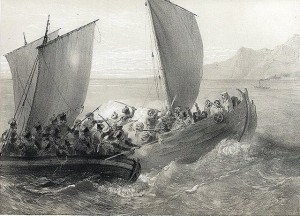
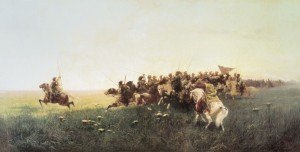
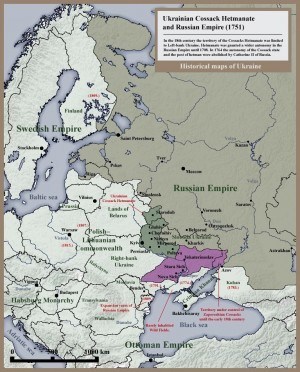
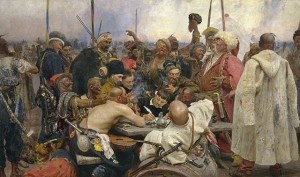
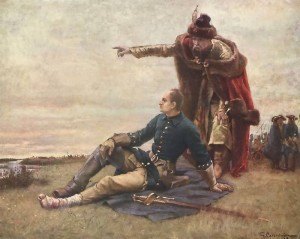
The horse was first dometicated in the steppes of what is modern day Ukraine. This happened long before your Zaporozhian Cossack warriors.
Yes, the horse was most likely domesticated on the Ukrainian steppes, most likely between 4 thousand and 5 thousand BC.
There’s been recent speculation, and maybe some evidence, that domestication may have occurred in what is now Kazakhstan. I can’t remember where I read that.
Yeah I’ve read that too. The area from the Ukraine all the way to Kazakhstan used to be one long steppe, so different nomadic groups moved around it all the time. This area is also supposed to be ancestral area of all Indo-Europeans, as well.
Fascinating history really, especially the steppes. The domestication of the horse is so fascinating, and so important. On a side note, have you heard of the Ukok Plateau?
Yes, the Pazyryk culture. I have read about it, although have to admit that don’t know too many details. I know that they were most likely Scythians. The Scythians actually used to roam the steppes of Ukraine and all the way to Siberia. Some Scythian groups from Central Asia even ended up conquering parts of India.
You should also check out the Tokharians.
Has anyone worked out which people were there originally? Was it always the Slavs and/or their precursors?
Your Cossacks may have been ubermensch but I doubt very much that they were dead shots from horseback. In the early 1600’s continuing thru most of that century, a firearm was a matchlock and not only that they were smoothbore matchlocks. At least in the first part of the 1600’s weapons were fired from a shooting stick, darned hard to do from the back of a horse. Firing one was a tedious procedure requiring that the match (a length of rope) was lighted, then it was clamped to the weapon, then the length was adjusted so it would strike the pan properly, then the weapon was shouldered (it was 4 to 5 feet long) and the pan was opened exposing the primer charge. And then finally you could fire the weapon.
Every example I’ve found of someone firing a matchlock online showed them loading the ball without wadding. If that was the way they did it then tilting the gun barrel down would cause the ball to roll out of the barrel. All of this would seem to make it darned tough to do from horseback. Cossacks did have an excellent recurved bone and sinew bow. And they could probably get 10 arrows off in the time it would take to fire the matchlock once. And being a smoothbore no one was deadeye Dick with one. The Brits only required their troops to hit a 6 foot target at almost point blank distance to be considered proficient.
The description of Zaporozhian Cossacks as being good shots with the matchlock comes from Gogol’s Taras Bulba. However the reputation might come from later times when the descendants of the Zaporozhians fought in the Russian armies and used more modern guns.
Will this info help me game ukranian hotties?
Sure it will.
Be a bad ass.
LOL
The letter to the Sultan, if true, is my new favorite quote of the universe.
I bet his mother had a unibrow. Along with his father’s other concubines.
♥❧♥❧♥❧get over 13kM0NTH@ag23:
Going Here you
Can Find Out
►►► http://WorkOnlinePlus.uk/live1/position40…
✹✹✹✹✹✹✹✹✹✹✹✹✹✹✹✹✹✹✹✹✹✹✹✹✹✹✹✹✹✹
When I read that I remembered the response the spartans gave to xerxes at thermopylae. True, this cossacks were much more elloquent that the spartans, but I think the principle behind is the same.
The total confidence in your own strenght and the contempt for an an enemy that considers himself like a god, but doesn’t even deserve to be served.
I’m sure that Ivan Sirko fought with his soldiers, just like Leónidas did with his, fighting in the first line of battle in the right side of the phalanx(the most honorable and the most dangerous place to be because you don’t have the protection of the shield.)
A very pleasant read, showing us once more how patriarchal tradition helped to raise boys into men.
♥❧♥❧♥❧Morgan . I see what you mean… Paula `s blurb is nice… on monday I got a great Subaru Impreza from having made $6173 this-past/four weeks and even more than ten grand this past munth . with-out a doubt this is the most financially rewarding I have ever done . I began this 3 months ago and almost straight away started to make over $69, per-hour . you could check here
See here………
You Can Find Out…….
►►►►► http://www.SuperbOnlineJobWorks.Com
✹✹✹✹✹✹✹✹✹✹✹✹✹✹✹✹✹✹✹
IS THIS ROOSH HIMSELF SPAMMING THE COMMENTARY?
WHY IS THIS LEFT UP?
I love it. Please, recommend some books.
Amazon has a few good books on the history of them and all the different host of Cossack groups, they actually conquered Siberia for Russia and explored Alaska and the coast all the way down to California. The Don and Kuban Cossack host ended up being the two biggest but Google them and there are websites full of their exploits
There’s no way that letter’s real, but damn was it great to read.
It’s real and they got a Frenchman to write it since they were all illiterate
They were indeed badasses.
They were badasses. I am not sure about the legends but to my understanding they were feared throughout Eastern Europe.
It’s true, there’s a story of Austrians parading one in a cage that they captured to show locals they were human and could be beat
Fuck yeah, Cossacks saved Europe from mongols and took Kazan from the barbaric jihad
I nominate the RAF during The Battle of Britain for the next warrior article.
RAF fighter pilot Douglas Bader was so alpha it was fucking ridiculous.
A foul mouthed renegade whose commanding officers couldn’t control, who lost both his legs yet still became the most feared fighter pilot in the War with something like 20 enemy aircrafts shot down. He utilised a new diving attack manoeuvre that people considered insane. When he was eventually shot down and captured (possibly by friendly fire) the Germans treated him like a God and their own best pilot went to visit him in prison as a mark of respect.
Amazing story. Truly amazing. Surprised it’s not been covered yet
Brings to mind Billy Mitchell who took no crap off any stupid superior …
If I remember correctly, bader made so many escape attempts from POW that the krouts threw him in colditz.. And he then continued trying to escape, to the point where the krouts threatened to take his legs away. I always thought bader’s tin legs must have been bolstered, given the huge balls they were forced to carry about.
He did yeah.
He was an extreme personality. Totally different from his portrayal in the 1955 film “Reach for the Sky”, which as more interested in pandering to US biases on British men
If only we had more men like this and not the feminine faggots we have now. I have had a very deep respect for the Cossacks ever since I heard of them.
The Cossacks at the battle of balaclava turned their guns on their own men on the left flank during a British cavalry charge. Not very alpha in my book.
A real alpha is someone like Blair Mayne. He was one of the original SAS commanders. He would parachute into the enemies territory with a tape recorder playing Irish music strapped to his leg. He would wake up his men in a drunken state (he was a chronic alcoholic even during the war) and beat them up if they didn’t sing Irish songs. A rugby player, a lawyer and a boxer. The only reason he was never awarded the Victoria cross was because he was quite fond of knocking out his superiors.
Actually the Battle of Balaclava happened almost a hundred years after the Zaporozhian Host was destroyed. The Cossacks that fought at Balaclava were the Don Cossacks, a totally different group of Cossacks.
However history is not always straight-forward, you will always have heroes and cowards in any group.
The Huns have got to be next.
Cossacks were also responsible for many pogroms against polish jews and tax-farmers and attacks on the polish state and catholic church
Yes no one is perfect. Although at some points there were even ethnic Jewish officers among the Zaporozhian Cossacks, especially during the earliest periods. While the Zaporozhian Cossacks were mostly ethnic Ukrainians, they included many other nationalities. They did however become more and more attached to the Eastern Orthodox Church, especially in the later periods.
Fascinating people. Also James Bonds nemesis in goldeneye was a Cossack. Something about a British betrayal
Maybe they knew the Polish jews came from Khazaria? Lots of bad blood between the Khazarians and their neighbors through the history of that empire.
How to be super manly, lose everything, and be destroyed. Or maybe we should reflect on how not every barbarian attribute is a virtue at all times. Bravery and strength are good values to have, but inflexibility, disorganization and being controlled by your emotions are not.
Not necessarily, just one fatal mistake: Chmielnicki’s uprising (circa 1650) – the Cossacks chose to ally with Russia over Poland (the weaker country) – once Poland was eventually destroyed the Cossacks had no counterbalance against Russia.
Im sure the shining example that is your life will supersede all the ancient tales of heroism such as this.
It is a privelege just to see your comment posted.
Their insulting the Sultan was very imaginative. Far more literary merit than most insults nowadays.
Great stuff, Cossacks are just bad motherfuckers. The advantage of Neomasculinity is that we can draw upon the Cossacks among many other (well countless) examples of real masculinity. Someone mentioned RAF pilots…you see from all over and throughout history we have these outstanding traditions and examples as our foundation. Fuck you feminism, you don’t stand a chance.
Wasn’t this how Rome – splendor of masculinity – also started? A bunch of outlaws and bad-asses who gradually gathered on a hill that later became known as Capitol.
Yes! The outlaws and badasses gathered on a hill, soon enough they realized they needed more women so Romulus planned the kidnapping a bunch of Sabine women. The infuriated Sabine men returned and fought the Romans over the women, but the women soon stopped the fighting, preferring the badass Romans and told the Sabine men to go home and they did haha
What an epic letter, they really wanted to fuck the sultan’s mother apparently. Important lesson here, better to die on your feet than to live on your knees.
Needless to say that both letters are fake.
But in any case, almost everybody was masculine at that time, except for eunuchs and effeminates. And they were masculine because of their way of life. It is not enough to stand for one’s liberty or anything similar. One or two trait or action does not make you masculine, it is your whole way of life.
I’m going to start using “Macedonian wheelwright” as an insult.
The Cossacks were persecuted under the Soviet regime but have been revived in their full patriarchal glory after that regime fell. Here is a BBC report on them :
http://news.bbc.co.uk/2/hi/europe/6937562.stm
The article reports that the Cossacks have a rigid hierarchical society where the men provide for their families and the women stay home to cook, take care of the house and raise children. Cossacks are expected to have many children and so their families are big. Also, the oldest man’s word is law in their communities.
That group photo you have which is the lead into this website: Those are not, I repeat NOT Zaporozhian Kozaks. Those are Kubani Kozaks! They are ethnically and territorially completely different from the ZaporozhianKozak Host. They don’t even dress the same! How can you post a website about Kozaks (NOT cossacks!) if you can’t even tell the difference between a Zaporozhian and a Kubani???